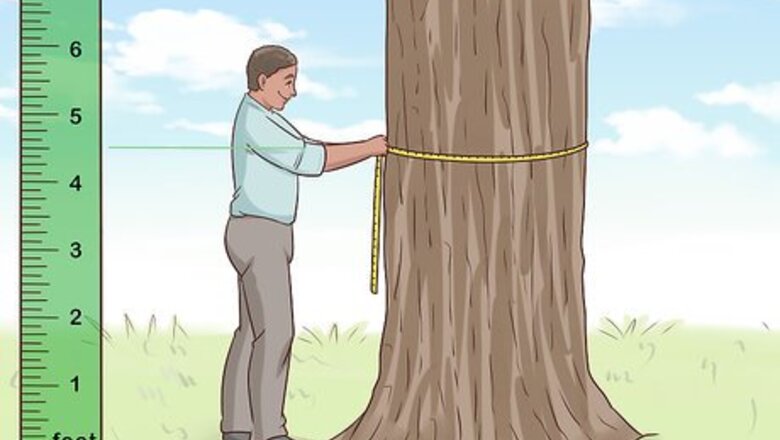
views
Estimating Age by Measuring the Trunk
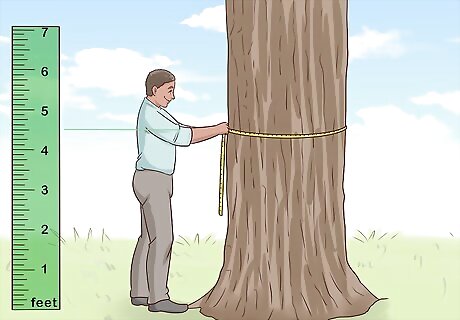
Measure the tree’s circumference at breast height. Average breast height, which is a forestry measurement, is 4 ⁄2 ft (1.4 m) from ground level. Wrap a fabric measuring tape around the trunk at this height, and note the tree’s circumference. If the ground is sloped, measure 4 ⁄2 ft (1.4 m) from ground level on the uphill side, mark the spot, then do the same on the downhill side. The average breast height is the midpoint between the uphill and downhill measurements. For a trunk that forks at a height less than 4 ⁄2 ft (1.4 m), measure the circumference just below the fork.
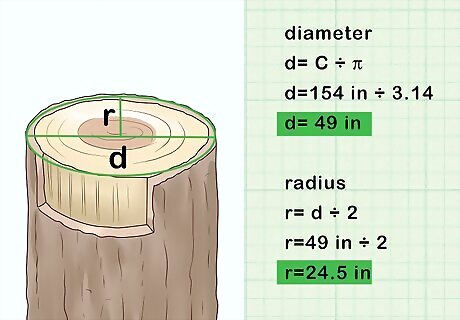
Find the trunk’s diameter and radius. To find the diameter, divide the circumference by pi, or approximately 3.14. Then find the radius by dividing the diameter by 2. For example, if the circumference is 154 in (390 cm), the diameter is approximately 49 in (120 cm), and the radius is about 24 ⁄2 in (62 cm).
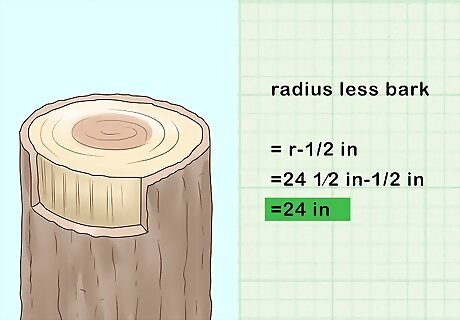
Subtract ⁄4 to 1 in (0.64 to 2.54 cm) to account for the bark. For tree species with thick bark, such as black oak, subtract 1 in (2.5 cm) from the radius measurement. Subtract ⁄4 in (0.64 cm) for species with thin bark, such as birch. If you’re not sure and just want a rough estimate, subtract ⁄2 in (1.3 cm) from the radius. Including the bark would add extra girth and throw off your measurements.
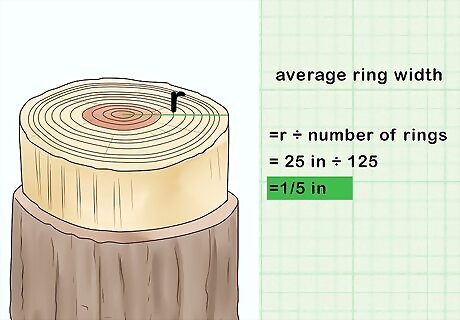
Use nearby fallen trees to calculate an average ring width. Check around the tree in question for dead or fallen trees of the same species. If you find one with visible rings, measure the radius and count the rings. Then divide the radius by the number of rings to find the average ring width. Suppose there’s a nearby stump with a radius of 25 in (64 cm), and you count 125 rings. The average ring width would be ⁄5 in (0.51 cm). Growth rates vary by tree species and environmental conditions. The living tree you’re measuring probably grew at a rate similar to a tree of the same species that grew nearby. You’ll plug your ring width measurement or, if there are no nearby stumps, an average growth rate into an equation to estimate the tree’s age. Even if you have the average ring width, you can also use the average growth rate to estimate the age, then compare the results of the 2 methods.

Look up the species’ average growth rate, if necessary. If you can’t find any nearby stumps or felled trees, search online for the average growth rate for the species of the tree you’re measuring. Including your location in your search terms could yield more accurate results. In general, a tree is probably around 8-15 years old for every 1 ft (0.30 m) of trunk diameter. For instance, if the circumference of a tree is 6 ft (1.8 m) around, it's probably at least 50 years old if it's a hardwood. For example, oak, ash, beech, and sycamore trees grow about ⁄2 to ⁄4 in (1.3 to 1.9 cm) in circumference per year. If you don’t know the species, plug both ⁄2 in (1.3 cm) and ⁄4 in (1.9 cm) into your equation to guess an age rage. For a more accurate estimate, factor in the tree’s location. In open conditions, growth rates are usually greater, or ⁄4 to 1 in (1.9 to 2.5 cm) per year. Growth tends to be slower in urban locations and crowded forests. Be sure to check how the growth rate is calculated. Many sources base growth rates on how much the tree’s girth, or circumference, grows per year. However, you might find rates based on the average ring width of the radius.
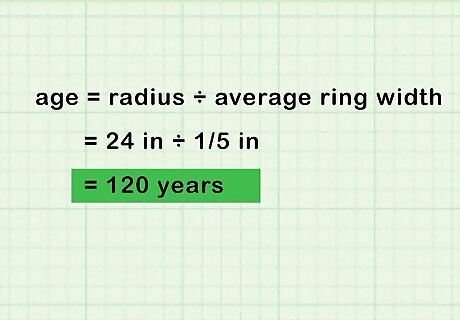
Divide the radius by the average ring width. If you used a nearby stump to calculate the average ring width, divide the radius of the living tree in question by the average ring width. Say that, excluding the bark, your tree has a radius of about 24 in (60.96 cm). Using a nearby tree stump of the same species, you calculated an average ring width of 0.20 in (0.508 cm). Divide 24 (or 60.96) by 0.20 (or 0.508) to come up with an estimated age of 120 years.
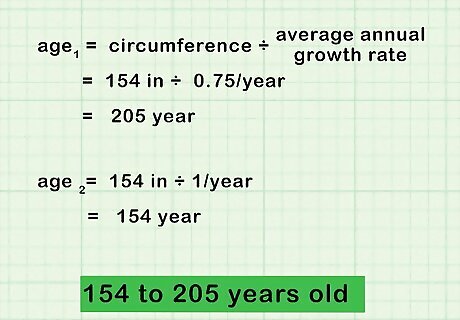
Divide the circumference by the average annual growth rate. If you found the average annual growth rate based on girth, or circumference, divide your tree’s circumference by the growth rate. Suppose your tree’s circumference is 154 in (391.16 cm), and its growth rate is between 0.75 and 1 in (1.905 and 2.54 cm) per year. Divide 154 (or 391.16) by 0.75 (or 1.905), then divide 154 (or 391.16) by 1 (or 2.54). Your estimated age range would be between 154 and 205 years old.
Counting Branch Whorls
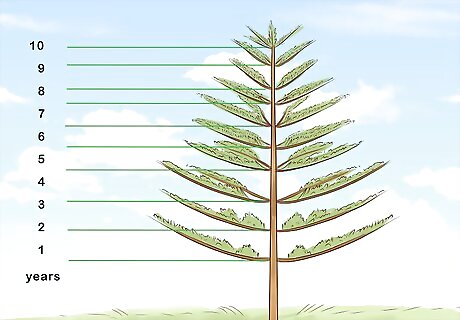
Count whorls to estimate the age of a conifer. Whorls are rows of branches that grow from the trunk at approximately the same height. Counting whorls is an option for conifers, or evergreen trees, but isn’t very useful for broadleaf trees, like oak or sycamore. This method isn't as accurate as counting the rings, but it's a way to estimate the tree's age without having to kill or injure it. Conifers produce whorls annually at regular intervals. Deciduous, or broadleaf trees, produce them irregularly, making it difficult to get an accurate count. It’s also easiest to count the whorls of a young conifer. You might not be able to see the top of a tall, mature conifer, and there would be more irregularities in its growth patterns.
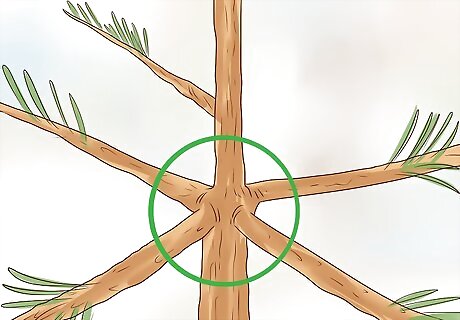
Count the rows of branches growing at the same height. At the base of the tree, look for a row of branches that grow at the same level, a bare length of trunk, then another row of branches. These rows are the whorls; count them until you’ve reached the top of the tree. You might see single branches growing between whorls or 2 whorls spaced closely together. These are irregularities that might indicate an injury or unusual weather conditions that year, so don’t count them.
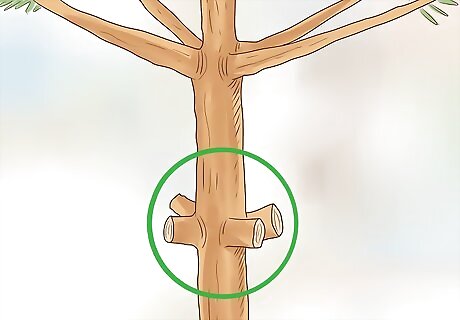
Include any stubs or knots at the bottom of the trunk. Check beneath the first row of branches for evidence of prior growth. Look for knots in the trunk and stubs where branches once grew, which you’ll count as additional whorls. For instance, suppose your tree has 8 recognizable whorls. Beneath the first row, you can see a few stubs that emerge from the trunk around the same level. There's also a row of 2 or 3 knots under the stubs. You’d count the stubs and knots as additional whorls, so your total count would be 10.
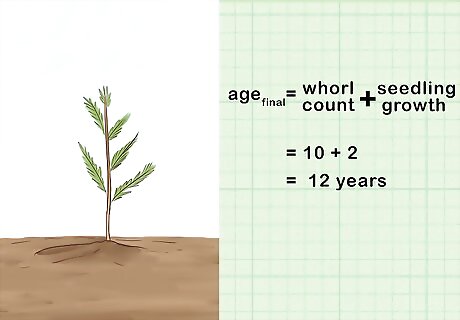
Add 2 to 4 years to account for seedling growth. The tree germinated and grew as a seedling for a few years before it started sprouting woody whorls. Add 2 to 4 to your whorl count to factor in this early growth. If your whorl count was 10, your final age estimate would be between 12 and 14 years.
Counting the Rings on a Stump
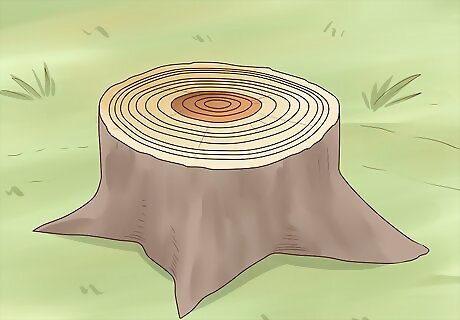
Examine the rings of an exposed stump. The number of rings on a stump indicates the number of years the tree lived. You’ll see rings of darker and lighter bands; 1 year of growth is composed of both a dark and light band. Since they’re easier to distinguish, count the dark bands to estimate the age. The rings can also tell you about the environmental conditions for a particular year. Thinner rings represent colder or dryer years, and thicker rings represent better growing conditions.
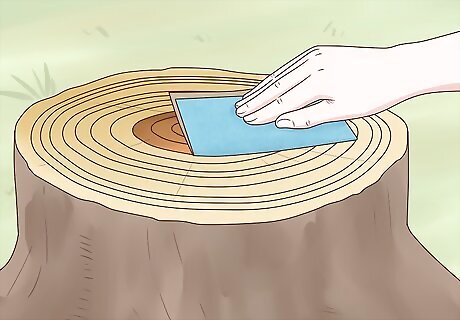
Sand the stump to see the rings more clearly. If the rings are hard to make out, start by sanding them with coarse, 60-grit sandpaper. Finish with a very fine sandpaper, such as 400-grit. Spraying the surface lightly with water can also make the rings easier to see. You might find that some rings are too close together to see clearly. If necessary, use a magnifying glass to get a better view.
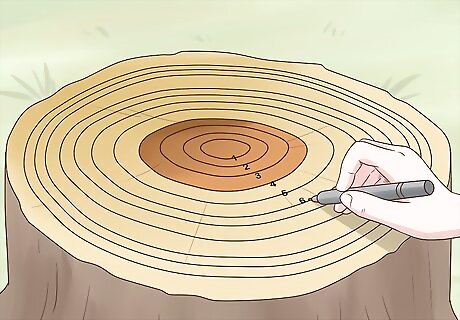
Count the rings from the pith to the bark. Find the pith, or the small circle at the center of the concentric rings. Start counting from the first dark band around the pith. Continue counting until you’ve reached the bark. The last ring is pressed up against the bark and hard to see, so make sure to include it in your count. If you have trouble keeping track, try writing a number or making a mark every 10 rings with a pencil.
Counting Rings on a Core Sample
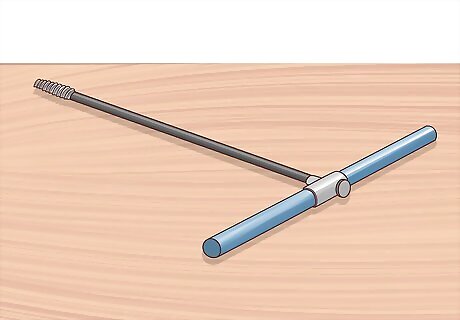
Take a core sample of a living tree using an increment borer. To accurately estimate the age of a living tree without killing it, use a borer to take a core sample. An increment borer is a T-shaped instrument composed of an augur, or a bit, and an extractor, which fits into the augur. The end of the T-shape is a handle, which you turn to drill in and out of the tree. The length of your increment borer should be at least 75% of the tree's diameter. You can find increment borers online and at forestry supply stores.
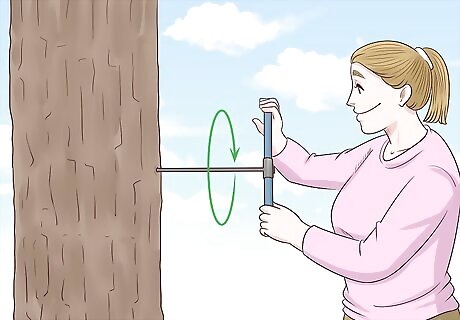
Drill into the trunk at breast height. Measure 4 ⁄2 ft (1.4 m) up the trunk from ground level. Position the borer’s bit at that height on the middle of the trunk. Taking a sample at breast height gives you an estimate called the DBH age. You'll need to add 5 to 10 years to the DBH age to estimate the tree’s total age. You'll take the sample at breast height because it’s not practical to take one at the tree’s base. Roots, brush, and the ground would prevent you from turning the handle, and it’s hard to drill while crouching or lying on the ground.
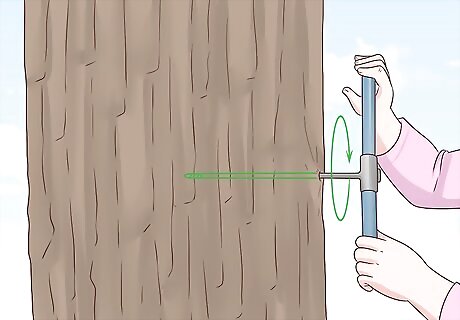
Bore just past the trunk’s estimated center point. Apply firm pressure and turn the handle clockwise to drill into the tree trunk. Continue turning until you think you’ve drilled around 2 to 3 in (5.1 to 7.6 cm) passed the pith, or the center of the trunk. Calculate the tree’s radius to estimate how far you’ll need to drill. Measure the tree’s circumference, divide by pi (about 3.14) to find the diameter, then divide the diameter by 2 to find the radius.
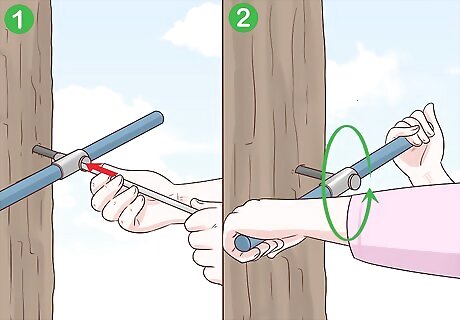
Insert the extractor, then turn the handle counterclockwise. The extractor is a long tube with teeth at an end. It fits into the augur, or the part that you’ve drilled into the tree. Slide in the extractor, then turn the handles clockwise to remove the instrument and extract a core sample.
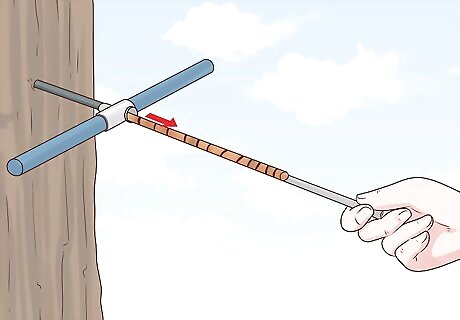
Remove the sample and locate the pith, or the center of the trunk. After sliding the core sample out of the extractor, you’ll see an array of curved concentric lines. These are sections of the tree’s rings. You should see a dot at the interior end (opposite the bark end) of the core sample that marks the center point of the concentric rings. If you don’t see the pith, place the sample on a large sheet of paper, and extend the curved lines to make full rings on the paper. Based on the rings you’ve drawn, try to guess where the center point would be, and estimate how many rings you’re missing.
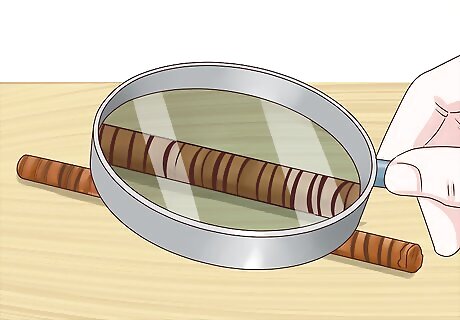
Count the rings on the core sample. After you’ve found the pith at the sample’s interior end, count the dark curved lines until you’ve reached the bark end of the sample. Use a magnifying glass if you have trouble seeing tightly clustered rings. If you have trouble making out the curved lines, sand the sample to make them more visible. Start with 60-grit sandpaper, then finish with a fine grit, such as 400. Remember that your ring count gives you the tree’s DBH age estimate. Add 5 to 10 years to estimate the tree’s total age.



















Comments
0 comment